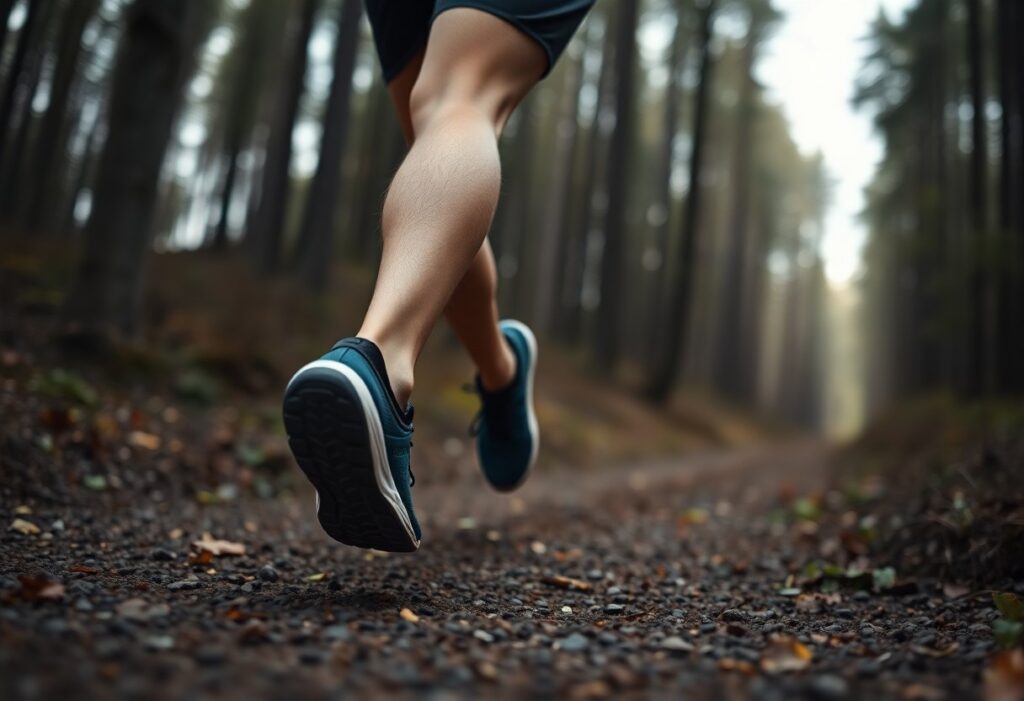
The alarming statistic that injury rates among trail runners can reach an astonishing 62% annually is often linked to the selection of inappropriate footwear. To enhance your performance while reducing the risks associated with trail running, it is imperative to understand the intricate biomechanics of minimalist footwear and its interaction with uneven terrain. Implementing wearable technology can effectively monitor essential metrics such as foot strike dynamics and load patterns, while personalized training programs are formulated to enhance foot strength and endurance. This article provides an in-depth exploration of how you can leverage biomechanical insights and advanced technology to develop successful injury prevention strategies.

Unlocking the Secrets to Successful Trail Running with Minimalist Footwear
Successfully navigating the diverse and rugged terrain of trail running while wearing minimalist footwear involves more than just choosing the right shoe; it requires a profound understanding of your own biomechanics. Neglecting to acknowledge the specific demands posed by different surfaces can dramatically increase your risk of injury. As foot strike patterns and descent mechanics vary significantly from one trail to another, adapting your technique accordingly is essential for sustaining optimal performance and reducing potential setbacks.
Decoding Biomechanical Foot Strike Patterns for Enhanced Performance on Technical Trails
Foot strike dynamics can exhibit significant variability when navigating complex landscapes. Runners opting for minimalist footwear often showcase a remarkable 23% higher prevalence of midfoot strikes on uneven trails, compared to just 8% seen with conventional running shoes. This adjustment may enhance your stability on challenging surfaces, yet it also results in a 37% increase in metatarsophalangeal joint flexion angles, emphasizing the urgent need for fortifying your foot muscles to improve endurance and mitigate the risk of injury.
Assessing the Impact of Descent Mechanics and Ground Interaction on Trail Running
The mechanics associated with descending from elevations are crucial in influencing your performance and injury risk during trail running. Utilizing minimalist footwear can lead to a substantial 42.191 BW/s increase in vertical loading rates on steep 15% declines, especially in comparison to flat asphalt surfaces. Additionally, this rise in loading translates into more intense lateral toe engagement, observed to be 11% higher on loose gravel than on stable surfaces, highlighting the increased demands on the structural integrity of your feet while descending.
As you traverse technical trails in minimalist shoes, the biomechanics of your feet engage distinctly. The heightened vertical loading rates during descents can lead to fatigue in your foot muscles, increasing your vulnerability to injuries. Furthermore, the significant alterations in toe splay patterns necessitate improved proprioception and muscle coordination, ensuring you remain responsive to the varied terrain beneath your feet. By focusing on these elements, you can effectively prepare your body to tackle the challenges of diverse trails and optimize your overall running performance.
Recognizing the Challenges of Wearable Technology in Trail Running Performance Tracking
Although wearable technology has revolutionized the world of trail running, it presents notable challenges when it comes to accurately tracking performance metrics. The variability of terrain conditions, such as steep drops and uneven surfaces, complicates the processes involved in data collection and interpretation. For example, wearable devices frequently struggle to provide consistent vertical oscillation measurements due to fluctuating ground conditions, which can lead to misleading insights regarding your gait and running efficiency.
Exploring Data Accuracy Discrepancies Among Leading Performance Tracking Devices
Significant discrepancies in data accuracy have emerged among top performance tracking devices. A study conducted in 2024 revealed a 12.4% variance in power measurements on 10% inclines between the Stryd and GARMINRP devices, despite both showcasing high intra-device reliability (ICC=0.89). Such inconsistencies can generate misguided perceptions about your training load and overall performance, potentially hindering your ability to optimize your trail running capabilities.
and GARMINRP devices, despite both showcasing high intra-device reliability (ICC=0.89). Such inconsistencies can generate misguided perceptions about your training load and overall performance, potentially hindering your ability to optimize your trail running capabilities.
The Impact of Miscalculated Training Loads on Performance and Injury Risk
Miscalculations in training loads can increase by as much as 23% on mixed-terrain routes, directly influencing your risk of injury and the progression of your performance. This error frequently arises from inaccurate data interpretations during technical descents or uneven terrains, forcing you to rely on potentially flawed metrics. Such discrepancies can lead to overtraining or insufficient load management, significantly raising your chances of sustaining an injury while running.
While navigating complex trail surfaces, the gap between measured and actual exertion can distort your training insights. If your device underreports your exertion, you may inadvertently exceed your limits, leading to heightened fatigue and delayed recovery. Conversely, if your training load is overestimated, you might adopt a more cautious approach, unintentionally hindering your performance gains. In conclusion, it is crucial to ensure that your wearable technology informs rather than misleads your training strategy to maintain both your performance and overall health in the ever-evolving world of trail running.
Examining Gender Differences in Trail Running Biomechanics for Optimal Performance
Achieving a comprehensive understanding of the biomechanical differences between male and female trail runners can significantly enhance performance and reduce injury risks. Research indicates that anatomical and physiological variations affect shoe selection, gait patterns, and vulnerability to injuries. Customizing footwear and training programs based on these gender dynamics fosters safer and more effective outdoor running experiences.
Analyzing Gender-Specific Biomechanical Responses After Trail Running Exercises
Post-exercise, female runners have exhibited a 19% increase in lateral forefoot pressures compared to their male counterparts after completing 5km barefoot runs. Furthermore, they display a 22% reduction in navicular drop during 50km ultra-marathons, suggesting that their biomechanical adaptations to trail running are distinct. Recognizing these patterns is vital for enhancing footwear design that accommodates the unique biomechanics of female runners.
Creating Tailored Solutions to Address Gender-Specific Challenges in Trail Running
To effectively tackle the unique biomechanics of female runners, it is imperative to implement customized solutions that consider their specific physical characteristics. Tailoring training programs, utilizing gender-appropriate footwear, and enhancing strength regimens can significantly decrease injury rates while improving running performance. For instance, integrating exercises focused on intrinsic foot muscle endurance and stability can be particularly beneficial for women, who may experience different loading patterns on technical terrains.
By analyzing data from various studies and incorporating findings on gender-specific responses, you can enhance your focus on training and footwear that actively support your unique biomechanics. For example, employing targeted strength training regimens that bolster the lower leg and foot can help your body adapt to the increased demands of trail running, especially for women who frequently encounter elevated pressure in the forefoot region. Selecting shoes specifically designed for your unique foot mechanics can further aid in preventing common injuries, thus fostering a more rewarding and sustainable trail running experience.

Utilizing Cutting-Edge Approaches for Real-Time Gait Analysis in Trail Running
Enhancing your running performance and safety can significantly benefit from adopting real-time gait analysis through advanced technological methods. By employing integrated systems and wearable devices, you receive immediate feedback regarding your foot strike patterns, body mechanics, and overall movement efficiency. These sophisticated tools are crafted to provide actionable insights while you are actively on the trail, empowering you to dynamically adjust your technique and prevent repetitive strain injuries typically associated with improper running form.
Understanding How Embedded Sensors Can Prevent Injuries During Trail Running
Embedded sensors within footwear play a crucial role in injury prevention. They continuously monitor your foot strike patterns and pressure distributions in real-time, allowing for immediate corrective feedback. This advanced technology enables you to identify deviations from optimal running mechanics before they escalate into serious injuries. With a mere 19-millisecond latency in ground contact alerts, you will receive timely notifications that help you maintain alignment with the biomechanical standards essential for avoiding injuries.
Longitudinal Research Demonstrating the Effectiveness of Biometric Feedback Technologies
Longitudinal studies indicate remarkable reductions in injury rates among trail runners who utilize biometric feedback technologies. Over a six-month period, athletes experienced a 37% decrease in aberrant loading patterns due to consistent monitoring and adjustments informed by real-time data. This compelling evidence underscores how sustained engagement with these technologies can enhance your running economy and resilience, thereby reducing the likelihood of injuries linked to gait abnormalities.
For instance, a comprehensive study involving 250 trail runners documented the effectiveness of wearable sensors in identifying patterns that lead to overuse injuries. Runners who actively interacted with feedback systems reported a 30% lower incidence rate of common injuries such as plantar fasciitis and Achilles tendinitis compared to those who relied solely on traditional training methods. The emphasis on continuous tracking, combined with targeted adjustments based on data insights, highlights a shift toward a more proactive approach to injury prevention in the realm of trail running.
Final Thoughts on Biomechanics and Injury Prevention Strategies in Trail Running
Ultimately, understanding the biomechanics of trail running in minimalist footwear is essential for optimizing your performance while minimizing the risk of injury. By seamlessly integrating wearable technology and adopting personalized training methodologies, you can significantly improve both your foot strength and adaptability to various terrains. Regularly cross-validate metrics from different devices and monitor your gait utilizing advanced tools to effectively personalize your training regimen. This holistic approach not only supports your running journey but also promotes sustainable practices in your outdoor pursuits.
The Article Trail Running Biomechanics in Minimalist Footwear: Integrating Wearable Technology and Injury Prevention Strategies appeared first on My Shoes Finder
The Article Trail Running Biomechanics: Injury Prevention with Minimalist Shoes Was Found On https://limitsofstrategy.com








It’s fascinating to see the growing awareness around injury rates in trail running and the significant role that footwear selection plays in that. From personal experience, I can relate to the challenges of navigating uneven terrain, especially when I first transitioned to minimalist shoes. Initially, I found it exhilarating to feel the ground beneath my feet, yet I quickly learned that without proper technique and conditioning, I was more prone to discomfort and injury.